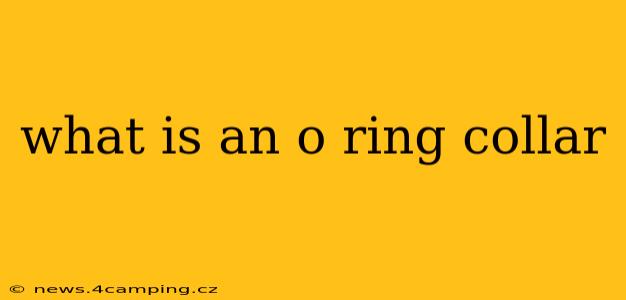An O-ring collar, sometimes called an O-ring groove, is a crucial component in many mechanical and engineering applications. It's a simple yet effective device that utilizes the elasticity and sealing properties of an O-ring to achieve a variety of functions, primarily focusing on sealing, fastening, and positioning. Understanding its purpose and applications is vital for anyone working with machinery, hydraulics, pneumatics, or other systems relying on reliable seals.
What is the Purpose of an O-Ring Collar?
The primary purpose of an O-ring collar is to provide a reliable seal against leakage. This is achieved by using a specially designed groove, or collar, that houses the O-ring. When properly assembled, the O-ring is compressed within this groove, creating a tight seal against the mating surface. This prevents the passage of fluids, gases, or other substances. Beyond sealing, O-ring collars also:
- Improve the life of seals: By providing a defined and protected space for the O-ring, the collar reduces the chances of damage or premature failure.
- Aid in positioning components: The collar can help precisely position components within an assembly.
- Enhance clamping force: In some applications, the collar can contribute to overall clamping force, improving the seal's effectiveness.
How Does an O-Ring Collar Work?
The effectiveness of an O-ring collar hinges on several factors:
- O-ring material: The choice of O-ring material is crucial, depending on the application's specific requirements for temperature, pressure, and compatibility with the sealed fluid or gas. Common materials include nitrile (NBR), Viton (FKM), silicone, and EPDM.
- Collar design: The collar's dimensions, particularly the groove depth and width, must precisely accommodate the chosen O-ring. Improper dimensions can lead to inadequate compression or excessive deformation of the O-ring, compromising its sealing capability.
- Surface finish: Smooth and properly finished mating surfaces are essential for a leak-free seal. Rough surfaces can damage the O-ring or prevent it from making proper contact.
- Installation: Proper installation is critical. Incorrect installation can damage the O-ring or prevent it from achieving an effective seal.
What are the Different Types of O-Ring Collars?
While the basic principle remains consistent, O-ring collars come in various designs, depending on the specific application. These variations often relate to:
- Material: Collars themselves can be manufactured from various materials, chosen for their strength, durability, and resistance to the operating environment. Common materials include metals (steel, aluminum, etc.) and plastics.
- Shape: The groove design can vary, with different shapes optimized for different applications and pressure levels.
- Size: O-ring collars are available in a wide range of sizes to accommodate various O-ring sizes and application needs.
What are Some Common Applications of O-Ring Collars?
O-ring collars find widespread use across numerous industries:
- Hydraulic systems: Sealing hydraulic cylinders and valves to prevent leakage.
- Pneumatic systems: Providing airtight seals in pneumatic actuators and control systems.
- Automotive industry: Sealing engine components, transmissions, and other critical parts.
- Aerospace industry: Sealing critical components in aircraft and spacecraft.
- Medical devices: Ensuring fluid tightness in medical instruments and equipment.
What are the Advantages of Using O-Ring Collars?
- Cost-effectiveness: O-rings and their collars are relatively inexpensive compared to other sealing methods.
- Ease of installation: Generally easy to install and replace.
- Reliability: Provide dependable sealing performance across a wide range of applications.
- Wide availability: O-rings and collars are widely available in various sizes and materials.
What are the Disadvantages of Using O-Ring Collars?
- Temperature limitations: O-ring materials have specific temperature operating ranges. Exceeding these limits can damage the O-ring and compromise the seal.
- Pressure limitations: O-rings are limited in their ability to withstand high pressures.
- Susceptibility to damage: O-rings can be susceptible to damage during installation or from debris in the system.
How to Choose the Right O-Ring Collar?
Selecting the appropriate O-ring collar requires careful consideration of several factors:
- Operating pressure and temperature: The collar and O-ring must withstand the operating conditions.
- Fluid or gas compatibility: The O-ring material must be compatible with the sealed substance.
- Collar material: The collar material should be compatible with the operating environment.
- Size and dimensions: The collar dimensions must accurately match the chosen O-ring.
By understanding the fundamental principles and considerations surrounding O-ring collars, engineers and technicians can leverage these simple yet effective components to achieve reliable sealing and precise positioning in a wide array of applications. Remember to always consult relevant technical specifications and industry best practices when selecting and installing O-ring collars.
